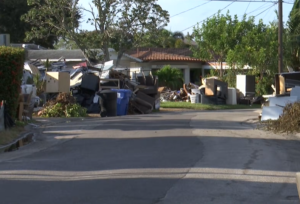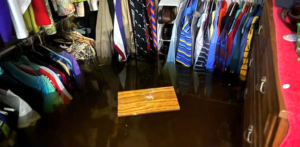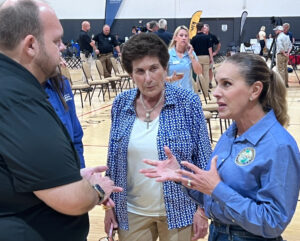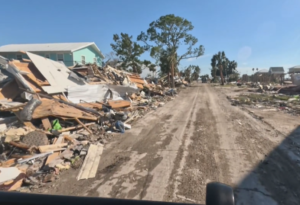Most losses appear to be from flood, not wind
Recovery from Florida’s other big hurricane this season – Helene – has had to take a backseat to Milton. Arriving just 13 days before Milton, the Category 4 hurricane is now responsible for 20 deaths in Florida, among the 231 lives lost across the Southeast and is the second deadliest storm in 50 years (behind Katrina). Florida officials say the deaths and widespread flooding prompted many more coastal residents to flee Milton. There are lots of updates to share, including insured damage.

Dump trucks filled with Hurricane Helene debris, like these in Bradenton on October 8, 2024, made continual round-the-clock trips to landfills to beat Hurricane Milton’s arrival
Damage & Debris: With tons of Helene debris still curbside in Florida’s West Coast counties as Milton approached last week, state officials marshalled 150 extra dump trucks and personnel to complement counties’ efforts to remove it. About 270,000 cubic yards of debris was removed throughout the state, “about half the debris that was there,” said Governor DeSantis. Helene damaged at least 30,000 structures in Florida with major damage to another 750 buildings. FEMA Director Deanne Criswell is asking residents requesting federal aid to make sure to list Helene damage distinctly from any Milton damage, with specific dates and documentation.

Curbside debris from Hurricane Helene in a Pinelllas County neighborhood, October 4, 2024
The same applies to Florida counties requesting federal reimbursement for pre- and post-landfall costs from the storms. Meanwhile, AccuWeather increased its estimate of the total damage and economic loss in the U.S. to $225 billion to $250 billion. The Verisk ALERT Team from AIR Worldwide data has completed its modeling and produced this Post-Event Wind and Storm Surge summary.
North Florida farmers near Helene’s landfall suffered “catastrophic” destruction of animals and crops that impacted cattle, nurseries, beehives, and agricultural processing plants, according to state Agriculture Commissioner Wilton Simpson. He received a federal agricultural disaster declaration and opened an interest-free loan program. Crop and farm infrastructure losses are estimated between $500 million and $800 million.

Cars were engulfed in sand on several streets in St. Petersburg Beach from Hurricane Helene’s storm surge. Courtesy, Pinellas County Sheriff’s Office
Insurance Claims: In Florida, Helene continues to be more of a flood than wind event. Storm surge of 6-8 feet in coastal Pinellas County flooded homes and businesses, pushing six feet of sand with it onto the streets of Treasure Island. As of this past Friday (October 11), insurance regulators report total estimated insured losses of $1.2 billion on 119,500 filed claims. Almost 23% of those claims are closed with a ratio of about 7 paid for every 6 unpaid.
Of the total filed claims, about 58,000 were automobile and 51,500 were residential property. Here’s the telling part: Nearly 22% of the automobile claims are closed, with 77% closed with payment. About 26% of the residential property claims are closed with only 35.5% closed with payment. The indication is that most claims were flood claims, not covered and therefore unpayable under a homeowners policy. There have been about 3,500 private flood insurance claims filed, with an incurred loss of $37.4 million (that averages to $10,600 per flood claim). Only 3% have been closed, with 56% of those closed with payment. It’s becoming very clear that too few residents had flood insurance – either federal or private.

Interior flooding in a Crystal River home from Hurricane Helene storm surge, September 27, 2024
Various catastrophic risk modelers estimate Helene’s multi-state insured flood losses (both private and National Flood Insurance Program policies) at between $6 billion to $11 billion. Estimated wind losses are another $4.5 billion to $6.5 billion. However, expected uninsured flood losses are huge: up to $30 billion – underscoring why more residents need to have flood insurance. Amid the destruction, was one Manatee County development that won’t be filing any insurance claims: a Miracle Florida neighborhood that survived Hurricane Helene without a scratch.

Lisa Miller (c) with Florida Insurance Commissioner Michael Yaworsky (l) and Rep. Karen Gonzalez Pittman (r) at the insurance village, October 4, 2024
Advice to Insurance Consumers: I attended the Helene insurance village on October in Clearwater to get a first-hand look at some of the insurance claims. The village serves as an opportunity for policyholders to meet with their insurance companies in-person and work together to file their claim. In all more than 30 carriers representing flood, automobile, and homeowners insurance were on hand to help. While there, I had the opportunity to talk with Insurance Commissioner Michael Yaworsky and with state Representative Karen Gonzalez Pittman (R-Hillsborough), whose district suffered some serious Helene damage.
I also spent a lot of time doing media interviews before and after Helene’s landfall, including this on-set interview with Fox 13’s Russell Rhodes (below). We talked about the impacts of Helene on Florida’s property insurance companies, where I stressed it will be a “manageable event,” given there have been so many flood claims, which are not covered by a homeowners policy. Helene, by itself, should have no real impact on homeowners rates. Regulators issued an Emergency Order extending grace periods on policies, and limitations on cancellations and nonrenewals.
Fraud: The Florida Department of Financial Services (DFS) Division of Criminal Investigations assigned “all available law enforcement resources” to the Disaster Fraud Strike Teams. The 13 teams of 80 law enforcement officers will “take appropriate legal action, including arrest, prosecution, and/or issuance of civil penalties for anyone who is engaging in fraudulent insurance practices…or otherwise seeking to take advantage of consumers through unfair or deceptive acts or practices.” So far, we have no reports of arrests. You can be sure these fine men and women will be out in full force during Hurricane Milton cleanup and recovery. There are other forms of hurricane fraud to be mindful of, as well as price gouging.

Damage remains in Horseshoe Beach, Florida on October 4, 2024 near Hurricane Helene’s landfall.
As we keep the victims of Milton and Helene in our minds and hearts, let’s remember, too, the residents of rural Taylor County, where Helene made landfall. It was the third hurricane to make landfall there in 13 months. They are also suffering and now face a myriad of questions and tough choices about the future, as chronicled in this touching article carried in the Insurance Journal.
LMA Newsletter of 10-14-24

